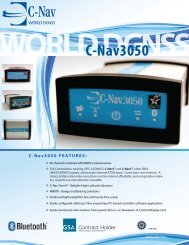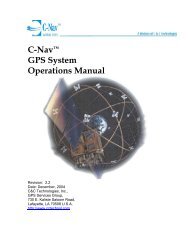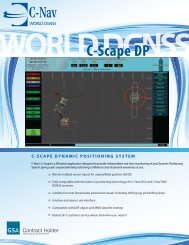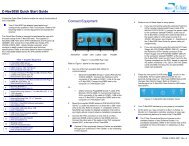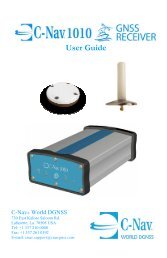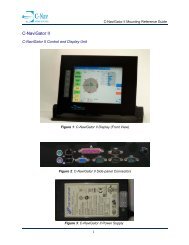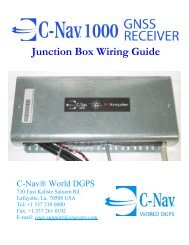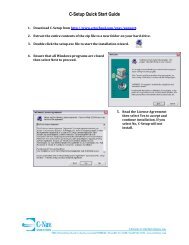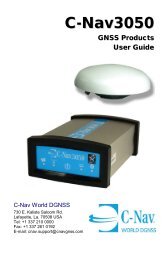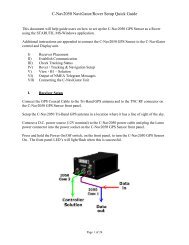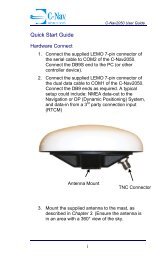Guidelines for the use of GNSS in surveying and mapping
Guidelines for the use of GNSS in surveying and mapping
Guidelines for the use of GNSS in surveying and mapping
Create successful ePaper yourself
Turn your PDF publications into a flip-book with our unique Google optimized e-Paper software.
Errors <strong>in</strong> <strong>the</strong> troposphere which are common to two<br />
receivers will cancel <strong>in</strong> <strong>the</strong> same way as <strong>the</strong><br />
ionospheric errors <strong>for</strong> relative position<strong>in</strong>g. However,<br />
<strong>the</strong> <strong>use</strong> <strong>of</strong> dual-frequency over long basel<strong>in</strong>es will<br />
not lead to any improvement. Absolute position<strong>in</strong>g<br />
errors can be up to several metres, if left<br />
uncorrected, although <strong>the</strong> application <strong>of</strong> one <strong>of</strong> <strong>the</strong><br />
st<strong>and</strong>ard models should reduce <strong>the</strong> effect to <strong>the</strong><br />
decimetre level, with errors <strong>in</strong> station height aga<strong>in</strong><br />
be<strong>in</strong>g <strong>the</strong> most pronounced.<br />
5.2 Multipath<br />
Multipath <strong>in</strong> <strong>GNSS</strong> measurements is a propagation<br />
error ca<strong>use</strong>d by <strong>the</strong> reflection <strong>of</strong> <strong>GNSS</strong> signals en<br />
route between <strong>the</strong> transmitt<strong>in</strong>g satellite <strong>and</strong> <strong>the</strong><br />
receiv<strong>in</strong>g antenna. Signals which have not followed<br />
<strong>the</strong> direct l<strong>in</strong>e <strong>of</strong> sight between <strong>the</strong> satellite <strong>and</strong><br />
receiver <strong>in</strong>terfere with <strong>the</strong> direct signals, <strong>and</strong> ca<strong>use</strong><br />
an error <strong>in</strong> <strong>the</strong> measurements. Multipath can occur<br />
at both <strong>the</strong> transmitt<strong>in</strong>g <strong>and</strong> receiv<strong>in</strong>g end <strong>of</strong> <strong>the</strong><br />
signal, i.e. at <strong>the</strong> satellite <strong>and</strong> at <strong>the</strong> ground<br />
antenna. The magnitude <strong>of</strong> <strong>the</strong> effect can reach<br />
several metres <strong>in</strong> pseudorange measurements, <strong>and</strong><br />
errors <strong>of</strong> this k<strong>in</strong>d directly affect <strong>the</strong> accuracy <strong>of</strong> a<br />
position<strong>in</strong>g solution. Fortunately, <strong>the</strong> effect on<br />
carrier phase measurements is about two orders <strong>of</strong><br />
magnitude less than on <strong>the</strong> code measurements.<br />
Although carrier phase may be <strong>the</strong> prime<br />
observable <strong>for</strong> survey<strong>in</strong>g <strong>and</strong> geodetic applications,<br />
<strong>the</strong> pseudorange measurements are <strong>use</strong>d <strong>in</strong> order<br />
to resolve <strong>the</strong> <strong>in</strong>itial ambiguities <strong>of</strong> <strong>the</strong> phase<br />
measurements.<br />
The effect <strong>of</strong> multipath is different <strong>for</strong> each satellite,<br />
<strong>and</strong> varies as <strong>the</strong> satellite moves across <strong>the</strong> sky.<br />
S<strong>in</strong>ce <strong>the</strong> effect is dependent on <strong>the</strong> location <strong>of</strong> <strong>the</strong><br />
receiv<strong>in</strong>g antenna, multipath errors clearly cannot<br />
be elim<strong>in</strong>ated by differential corrections. In fact, as<br />
multipath at a mobile receiver <strong>and</strong> multipath at a<br />
reference receiver are uncorrelated, <strong>the</strong>y may<br />
consequently have an additive effect.<br />
The factors which determ<strong>in</strong>e whe<strong>the</strong>r a particular<br />
<strong>GNSS</strong> <strong>in</strong>stallation is susceptible to multipath are<br />
many <strong>and</strong> varied. The location <strong>of</strong> <strong>the</strong> <strong>GNSS</strong><br />
antenna with respect to reflective surfaces, <strong>the</strong><br />
design <strong>of</strong> <strong>the</strong> antenna, <strong>the</strong> type <strong>of</strong> correlator <strong>in</strong> <strong>the</strong><br />
receiver, <strong>the</strong> signal to noise ratio, <strong>and</strong> <strong>the</strong> elevation<br />
<strong>and</strong> azimuth <strong>of</strong> <strong>the</strong> satellites, all contribute.<br />
5.2.1 Multipath – implications<br />
If an environment is ‘unfriendly’ <strong>in</strong> terms <strong>of</strong><br />
multipath, <strong>the</strong>n <strong>the</strong> best strategy is to observe over<br />
<strong>the</strong> longest possible period <strong>of</strong> time, <strong>in</strong> an attempt<br />
to average out <strong>the</strong> effect. This has obvious<br />
implications <strong>for</strong> methods which <strong>use</strong> rapid<br />
<strong>in</strong>itialisation such as medium precision static, where<br />
occupation times are typically <strong>of</strong> <strong>the</strong> order <strong>of</strong> 10 to<br />
15 m<strong>in</strong>utes, <strong>and</strong> <strong>for</strong> dynamic methods with<br />
observation durations <strong>of</strong> a few m<strong>in</strong>utes at <strong>the</strong> most.<br />
Determ<strong>in</strong><strong>in</strong>g <strong>the</strong> susceptibility <strong>of</strong> a location to<br />
multipath <strong>in</strong> both static <strong>and</strong> dynamic real-time<br />
<strong>GNSS</strong> survey methods is a problem which has<br />
been <strong>in</strong>vestigated. A critical test <strong>for</strong> static survey<br />
applications is given below, which should be <strong>use</strong>d<br />
only when absolutely necessary from a commercial<br />
po<strong>in</strong>t <strong>of</strong> view. It is far better to observe somewhere<br />
else <strong>and</strong> transfer a co-ord<strong>in</strong>ate to <strong>the</strong> required<br />
location us<strong>in</strong>g a traditional survey method. Antenna<br />
design is becom<strong>in</strong>g <strong>in</strong>creas<strong>in</strong>gly advanced to cope<br />
with <strong>the</strong> effects <strong>of</strong> multipath, through <strong>the</strong> <strong>use</strong> <strong>of</strong><br />
polarised antennas <strong>and</strong> choke r<strong>in</strong>gs. Fur<strong>the</strong>rmore, a<br />
consequence <strong>of</strong> phase-smooth<strong>in</strong>g is that multipath<br />
effects are attenuated, due to <strong>the</strong> reduced effect <strong>of</strong><br />
<strong>the</strong> multipath on <strong>the</strong> carrier phase.<br />
5.2.2 Multipath – critical test<strong>in</strong>g<br />
Various simple tests have been proposed to identify<br />
whe<strong>the</strong>r or not a given <strong>in</strong>stallation <strong>of</strong> a receiver<br />
actually suffers from a significant amount <strong>of</strong><br />
multipath, <strong>in</strong> ei<strong>the</strong>r <strong>the</strong> pseudorange or carrier<br />
phase measurements. In general, it can be<br />
assumed that <strong>for</strong> an antenna site which<br />
experiences multipath <strong>in</strong> carrier phase<br />
measurements, <strong>the</strong>re will also be an effect on <strong>the</strong><br />
pseudoranges, simply beca<strong>use</strong> <strong>the</strong> site has<br />
reflective surfaces <strong>in</strong> <strong>the</strong> vic<strong>in</strong>ity. However, <strong>the</strong><br />
effect on pseudoranges is not exactly <strong>the</strong> same as<br />
<strong>the</strong> effect on carrier phase, <strong>and</strong> could be many<br />
times larger. One st<strong>and</strong>ard method <strong>of</strong> identify<strong>in</strong>g<br />
carrier phase multipath is to exam<strong>in</strong>e residual plots<br />
on consecutive days. If trends can be seen from<br />
day to day, <strong>the</strong>n one can <strong>in</strong>fer that <strong>the</strong> results are<br />
38 | GUIDELINES FOR THE USE OF <strong>GNSS</strong> IN LAND SURVEYING AND MAPPING



